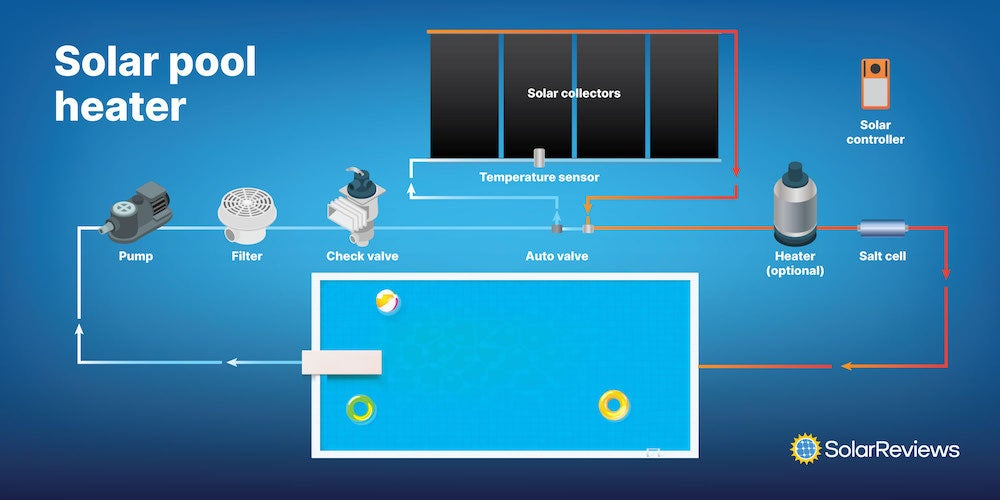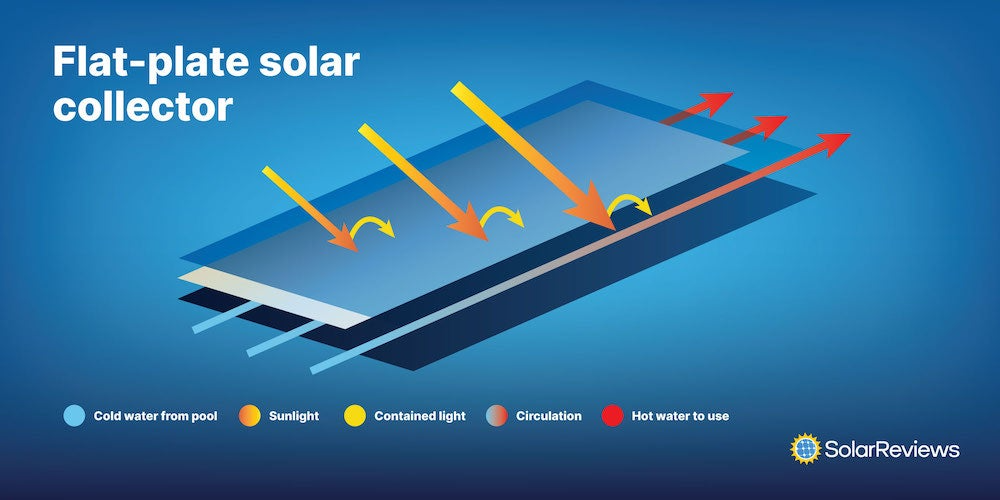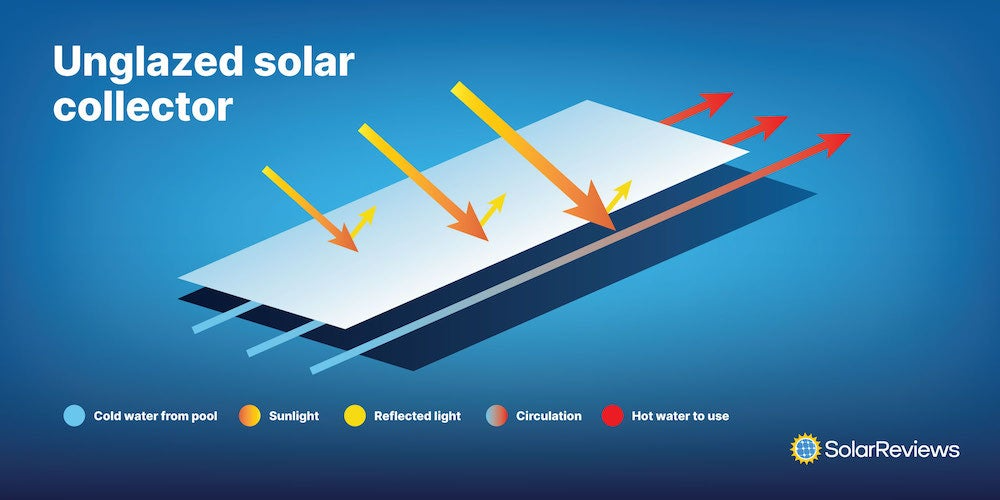Updated 2 months ago
Introducing the solar pool heater, a low-cost way to heat your pool
Written by
Chris Meehan
Find out what solar panels cost in your area
Installing a solar-powered swimming pool heater is a great way to not only warm up your pool, making it comfortable to swim in well past swimming season; it helps pool owners save money on heating costs, as well.
Costing between $1,500 and $8,000, solar pool heaters are a relatively affordable option. Your energy bill savings will also show a great return on your investment.
In this blog, we’ll tell you everything you need to know about solar pool heaters, and if they’re a worthy investment for your home.
How do they work?
First, pool water is pumped out from the pool through a filter, then to a solar thermal collector, where solar energy heats the water before returning it to the pool. The system also requires a check valve, flow control valve, and a sensor to keep the pool temperature in check.

Solar pool heaters utilize a solar thermal collector, check valve, flow control valve, and a sensor to produce hot water.
Most systems can automatically detect the temperature of the water and transfer it to the solar collector, which will heat the water before returning it to the pool. When the water reaches the desired temperature, the flow control valve then diverts the flow from the solar collector directly back to the pool.
In the colder parts of the US and in areas where the pool is used year-round, the solar collector is usually oversized - allowing it to keep heating the pool, even when there are significant drops in temperature.
A solar water heater can also be used in tandem with gas or electric heaters if needed.
Solar thermal collectors
Solar thermal collectors harness the thermal energy from sun exposure. Cool water is pumped through the collectors at the bottom. As the sun heats up the water, it rises to the top, where it can then be used to warm the water of pools.
Glazed vs. unglazed solar thermal collectors
There are two primary types of solar thermal collectors - glazed and unglazed.
Glazed solar collectors
Also known as flat-plate solar collectors, glazed solar collectors are encased in glass and are often more complicated in design, as they are built from metals (including copper tubing and aluminum plate) under an iron-tempered glass covering.

These systems can heat water more efficiently and require less space, which allows them to provide higher levels of heat. While glazed solar collectors are suitable for year-round use, they do cost more than unglazed solar collectors.
Unglazed solar collectors
These collectors are often made of black plastic or heavy-duty rubber and are ultraviolet (UV) treated to help extend their service life.

Unglazed solar collectors, while typically cheaper, are less effective and limited to warmer climates and pools whose temperatures don’t reach below freezing.
Which size solar collector is right for your home?
Depending on how many months out of the year you plan to use your pool and how warm you prefer your water to be, the Department of Energy (DOE) recommends the solar collector be between 50% and 100% of the square footage size of the pool’s surface.
So, a pool of 15-by-20 feet has 300 square feet of surface area. Therefore, the solar collector should be between 150 and 300 square feet in size.
Homeowners looking to keep their pool open throughout the year should consider a solar collector that is the full size of the pool or larger.
For example, a 15-by-30-foot outdoor swimming pool in Florida typically requires a collector that equals 100% of the pool's square footage to accommodate year-round use. This equals 450 square feet of collectors.
How much does it cost to install and operate a solar pool heater?
All in all, a fully-installed solar pool heater costs between $1,500 and $8,000. But, they can pay for themselves in energy bill savings.
You can also opt to power the pool pump with your solar system, which would lower the cost of heating your pool significantly.
Why you should consider making the switch to a solar pool heater
Solar pool heaters have many benefits over traditional gas or electric-powered heating systems. Solar pool heaters require very little maintenance. The only upkeep needed is making sure the solar collectors are clean so they can capture as much sunlight as possible.
The biggest benefit, however, is that solar pool heaters don’t need additional inputs to run. You don’t have to worry about paying for gas or electricity to heat up your pool. Just use the free sunshine that hits your roof!
Making the most of your solar pool heater installation
Taking simple measures, such as utilizing a pool cover to help retain heat, effectively reduces the costs associated with operating a solar-powered pool heater even further. Solar pool covers are designed to absorb more thermal energy from the sun and transfer it to the pool surface.
Since a solar pool heater requires both electrical and plumbing work, it is recommended that you contact a professional contractor to install the heating systems - especially if you are looking to place the installation on your roof.
Chris Meehan is a freelance writer for SolarReviews With more than a decade of professional writing experience, Chris focuses on sustainability, renewable energy and outdoor adventure articles. He has written for various publications, including 303 Magazine, Sun & Wind Energy and the Westword....
Learn more about Chris Meehan